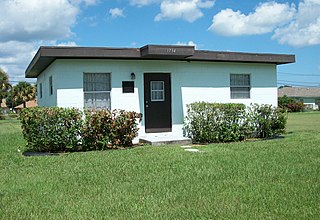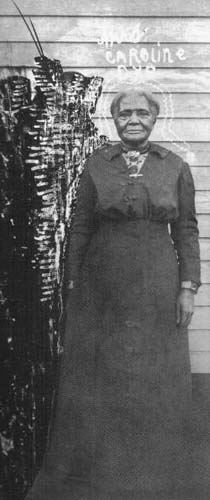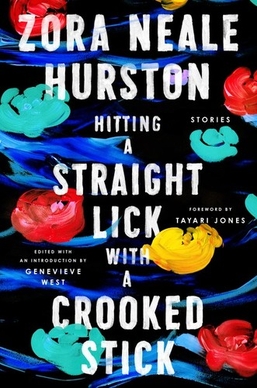
Zora Neale Hurston was an American author, anthropologist, and filmmaker. She portrayed racial struggles in the early-1900s American South and published research on hoodoo. The most popular of her four novels is Their Eyes Were Watching God, published in 1937. She also wrote over 50 short stories, plays, and essays.

Eatonville is a town in Orange County, Florida, United States, six miles north of Orlando. It is part of Greater Orlando. Incorporated on August 15, 1887, it was one of the first self-governing all-black municipalities in the United States. The Eatonville Historic District and Moseley House Museum are in Eatonville. Author Zora Neale Hurston grew up in Eatonville and the area features in many of her stories.

Hoodoo is a set of spiritual practices, traditions, and beliefs that were created by enslaved African Americans in the Southern United States from various traditional African spiritualities and elements of indigenous botanical knowledge. Practitioners of Hoodoo are called rootworkers, conjure doctors, conjure man or conjure woman, and root doctors. Regional synonyms for Hoodoo include rootwork and conjure. As a syncretic spiritual system, it also incorporates beliefs from Islam brought over by enslaved West African Muslims, and Spiritualism. Scholars define Hoodoo as a folk religion. It is a syncretic religion between two or more cultural religions, in this case being African indigenous spirituality and Abrahamic religion.

Their Eyes Were Watching God is a 1937 novel by American writer Zora Neale Hurston. It is considered a classic of the Harlem Renaissance, and Hurston's best known work. The novel explores protagonist Janie Crawford's "ripening from a vibrant, but voiceless, teenage girl into a woman with her finger on the trigger of her own destiny".

John the Conqueror, also known as High John de Conqueror, John, Jack, and many other folk variants, is a folk hero from African-American folklore. He is associated with the roots of Ipomoea purga, the John the Conqueror root or John the Conqueroo, to which magical powers are ascribed in African-American folklore, especially among the Hoodoo tradition of folk magic. Muddy Waters mentions him as Johnny Cocheroo in the songs "Mannish Boy" and "I'm Your Hoochie Coochie Man". In "Mannish Boy", the line is "I think I'll go down/To old Kansas too/I'm gonna bring back my second cousin/That little Johnny Conqueroo" and in "I'm Your Hoochie Coochie Man", it is called "John De Conquer Blue".
A black cat bone is a type of lucky charm used in the magical tradition of hoodoo. It is thought to ensure a variety of positive effects, such as invisibility, good luck, protection from malevolent magic, rebirth after death, and romantic success.
...Got a black cat bone
got a mojo too,
I got John the Conqueror root,
I'm gonna mess with you...

The Zora Neale Hurston House is a historic house at 1734 Avenue L in Fort Pierce, Florida. Built in 1957, it was the home of author Zora Neale Hurston (1891–1960) from then until her death. On December 4, 1991, it was designated as a U.S. National Historic Landmark.
African-American folktales are the storytelling and oral history of enslaved African Americans during the 1700s-1900s. Prevalent themes in African-American folktales include tricksters, life lessons, heartwarming tales, and slavery. African Americans created folktales that spoke about the hardships of slavery and told stories of folk spirits that could outwit their slaveholders and defeat their enemies. These folk stories gave hope to enslaved people that folk spirits would liberate them from slavery. One of these heroes that they looked up to was the charming High John the Conqueror, who was a cunning trickster against his slave masters. He often empowered newly freed slaves, saying that if they needed him, his spirit would be in a local root. Other common figures in African-American folktales include Anansi, Brer Rabbit, and Uncle Monday. Many folktales are unique to African-American culture, while others are influenced by African, European, and Native American tales.
"The Gilded Six-Bits" is a 1933 short story by Zora Neale Hurston, who is considered one of the pre-eminent writers of 20th-century African-American literature and a leading prose writer of the Harlem Renaissance. Hurston was a relative newcomer on the literary scene when this short story was published, but eventually had greater success with her highly acclaimed novel, Their Eyes Were Watching God. "The Gilded Six-Bits" is now published in Hurston's compilation of short stories entitled Spunk in which it is now considered one of her best stories. "The Gilded Six-Bits" is a story full of love, betrayal, and forgiveness. It portrays the life of two happy newlyweds who both test their relationship and their love for one another when a charismatic outsider comes into their community and into their home. The story embodies Hurston's typical writing style in which it focuses on the common African-American lifestyle, represented by regional dialect and metaphors, and is set in her native town Eatonville, FL where it reflects the traditions of the community. "The Gilded Six-Bits" symbolizes the meaning of a true marriage and the truth that lies underneath its meaning.

Mule Bone: A Comedy of Negro Life is a 1930 play by American authors Langston Hughes and Zora Neale Hurston. The process of writing the play led Hughes and Hurston, who had been close friends, to sever their relationship. Mule Bone was not staged until 1991, when it was produced in New York City by the Lincoln Center Theater.

Published in 1983, In Search of Our Mothers' Gardens: Womanist Prose is a collection composed of 36 separate pieces written by Alice Walker. The essays, articles, reviews, statements, and speeches were written between 1966 and 1982. Many are based on her understanding of "womanist" theory. Walker defines "womanist" at the beginning of the collection as "A black feminist or feminist of color. From the black folk expression of mother to female children and also a woman who loves other women, sexually and/or nonsexually. Appreciates and prefers women's culture. Committed to survival and wholeness of entire people, male and female. Womanist is to feminist as purple is to lavender."

Valerie Boyd was an American writer and academic. She was best known for her biography of Zora Neale Hurston entitled Wrapped in Rainbows: The Life of Zora Neale Hurston. She was an associate professor and the Charlayne Hunter-Gault Distinguished Writer-in-Residence at the Grady College of Journalism and Mass Communication at the University of Georgia, where she taught narrative nonfiction writing, as well as arts and literary journalism.

"Sweat" is a short story by the American writer Zora Neale Hurston, first published in 1926, in the first and only issue of the African-American literary magazine Fire!!. The story revolves around a washerwoman and her unemployed husband.

Dust Tracks on a Road is the 1942 autobiography of black American writer and anthropologist Zora Neale Hurston.
Jonah's Gourd Vine is Zora Neale Hurston's 1934 debut novel. The novel is a semi-autobiographical novel following John Buddy Pearson and his wife, Lucy. The characters share the same first names as Hurston's parents and make a similar migration from Notasulga, Alabama to Hurston's childhood home, Eatonville, Florida.
Moses, Man of the Mountain is a 1939 novel by African-American novelist and anthropologist Zora Neale Hurston. The novel rewrites the story of the Book of Exodus of Moses and the Israelites from an Afro-American perspective. The novel applies a number of different motifs and themes commonly addressed in African-American culture, subverting the Moses story.
"How It Feels To Be Colored Me" (1928) is an essay by Zora Neale Hurston published in World Tomorrow as a "white journal sympathetic to Harlem Renaissance writers", illustrating her circumstance as an African-American woman in the early 20th century in America. Most of Hurston's work involved her "Negro" characterization that were so true to reality, that she was known as an excellent anthropologist.
Ann Graves Tanksley is an American artist. Her mediums are representational oils, watercolor and printmaking. One of her most noteworthy bodies of work is a collection based on the writings of African-American novelist and anthropologist Zora Neale Hurston. The Hurston exhibition is a two hundred plus piece collection of monotypes and paintings. It toured the United States on and off from 1991 through 2010.

Caroline Dye also known as Aunt Caroline, was a renowned African American Hoodoo woman, rental property investor, soothsayer, rootworker and conjuror based in Newport, Arkansas.

Hitting a Straight Lick with a Crooked Stick is a compilation of recovered short stories written by Zora Neale Hurston. It was published in 2020 by Amistad: An Imprint of HarperCollins publishers. ISBN 978-0-06-291579-5











